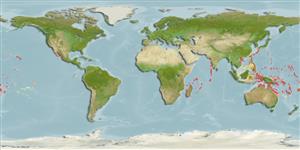>
Kurtiformes (Nurseryfishes, cardinalfishes.) >
Apogonidae (Cardinalfishes) > Apogoninae
Etymology: Apogon: Greek, a = without + Greek pogon = chin, beard (Ref. 45335); indicus: From the Latin indicus meaning 'of India' - in reference to the Indian Ocean where the holotype was collected and where it is the only member of the A. erythrinus complex (Ref. 40822).
More on author: Greenfield.
Environment: milieu / climate zone / depth range / distribution range
بوم شناسي
دريايي نزديك كف زي; تغييرات عمق 6 - 8 m (Ref. 40822). Tropical
Indo-Pacific: Mauritius to Kiribati.
Size / Weight / سن
Maturity: Lm ? range ? - ? cm
Max length : 3.8 cm SL جنس نر / بدون خواص جنسي; (Ref. 40822)
توصيف مختصر
كليدهاي شناسايي | ريخت شناسي | ريخت ستجي بوسيله انداره گيري
خارهاي باله پشتي (کل) : 7; شعاع نرم باله پشتي (کل) : 9; خارهاي باله مخرجي: 2; شعاع نرم باله مخرجي: 8. Differs from other members of the A. erythrinus complex by having the following characteristics: from A. erythrinus by having a shorter second dorsal fin spine not reaching base of third ray of second dorsal fin when depressed and by usually having 13 pectoral fin rays (versus 14); from A. marquesensis by lacking scattered dark chromatophores on sides of caudal peduncle that extend anteriorly as a band to vertical from caudal fin base to vertical from end of dorsal and anal fin rays (pigment extends forward as a band in A. marquesensis) and by usually having 13 pectoral fin rays (versus 14); from A. susanae by usually having 13 pectoral fin rays (versus 14), by having pigment along the base of the second dorsal fin and on the dorsal surface of the caudal peduncle (pigment lacking in A. susanae), by usually having a well-developed suborbital triangle of pigment (usually lacking or faint in A. susanae, and by having a well-developed pigment blotch on caudal fin base (variable, but often faint or absent in A. susanae (Ref. 40822). Further characterized by having 23 pored lateral line scales; predorsal scales 6; large scales between first dorsal fin and lateral line 2, with smaller third scale at base of dorsal fin; circumpeduncular scales 14; total gill rakers 15, developed gill rakers 7; without free edge of skin near anterior nasal opening (Ref. 93839).
Life cycle and mating behavior
بلوغ | تولید مثل | تخم ریزی | تخم ها | Fecundity | توزاد ( لارو)
Mouthbrooders (Ref. 240). Distinct pairing during courtship and spawning (Ref. 205).
Greenfield, D.W., 2001. Revision of the Apogon erythrinus complex (Teleostei: Apogonidae). Copeia 2001(2):459-472. (Ref. 40822)
وضعيت در فهرست قرمز IUCN (Ref. 130435: Version 2024-1)
خطر برای انسان ها
Harmless
استفاده انسانی
ابزارها
گزارش های ويژه
بارگيری XML
منابع اينترنتي
Estimates based on models
Preferred temperature (Ref.
123201): 25.4 - 29.3, mean 28.4 °C (based on 1889 cells).
Phylogenetic diversity index (Ref.
82804): PD
50 = 0.5000 [Uniqueness, from 0.5 = low to 2.0 = high].
Bayesian length-weight: a=0.01445 (0.00680 - 0.03071), b=3.07 (2.89 - 3.25), in cm total length, based on LWR estimates for this (Sub)family-body shape (Ref.
93245).
Trophic level (Ref.
69278): 3.3 ±0.4 se; based on size and trophs of closest relatives
جهندگی (Ref.
120179): زياد, كمينه زمان لازم براي دو برابر شدن جمعيت ، كمتر از 15 ماه (Preliminary K or Fecundity.).
Fishing Vulnerability (Ref.
59153): Low vulnerability (10 of 100).
